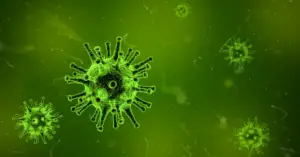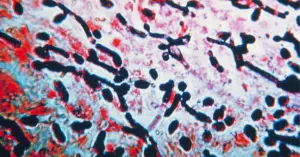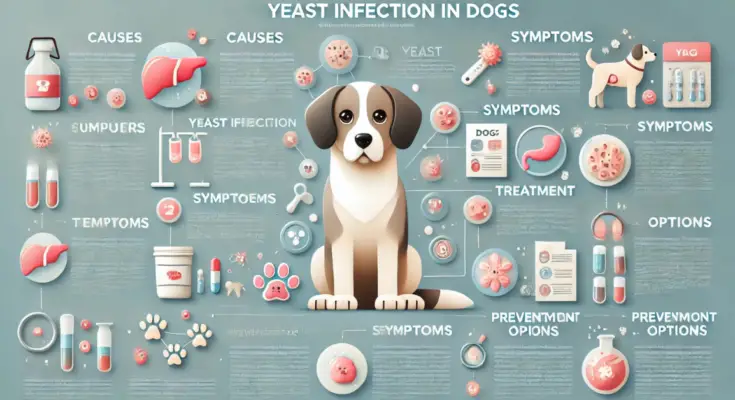Some dogs are prone to developing yeast infections in dogs, which can be uncomfortable for them. These infections need special treatment from a veterinarian to be cured, but certain home remedies may help manage your dog’s discomfort at home until you can get to the vet. Here’s what you should know about dog yeast infections and how to treat them.
What Are Yeast Infections in Dogs?
Yeast infections in dogs occur when naturally existing yeast on their skin grows out of control. Typically caused by the Malassezia fungus, these infections thrive in warm, moist areas. While yeast is harmless in small amounts, factors like a weakened immune system, underlying health conditions (e.g., hypothyroidism), or allergies can lead to overgrowth and infection.
Common areas affected by yeast infections in dogs include the ears, paws, skin folds, armpits, vulva, and groin. Dogs of all ages can experience yeast infections in dogs, which can cause discomfort, thickened skin, and discoloration over time.
Although yeast infections in dogs aren’t medical emergencies, they require prompt treatment to prevent worsening symptoms and secondary complications. Unlike bacterial or viral infections, yeast infections in dogs aren’t contagious to humans or pets.
Types of Yeast Infections in Dogs

- Yeast Infections in Ears
Also known as yeast otitis, these infections cause:- Brown, thick ear discharge
- A strong odor
- Itchy, red, inflamed ear canals
- Head shaking and scratching
- Potential head tilting
Long-eared breeds like Cocker Spaniels, Basset Hounds, and Labrador Retrievers are particularly prone to ear yeast infections in dogs, often linked to food allergies.
- Yeast Dermatitis (Skin Infections)
Yeast infections in dogs on the skin lead to: - Itchy, flaky, or thickened skin
- Greasy fur with a musty smell
- Hair loss
- Brown discoloration of the skin (from licking)
Common areas affected include skin folds, armpits, vulva, and groin. Dermatitis often stems from allergies or immune suppression.
- Yeast Infections in Paws
Paw yeast infections in dogs can result from environmental allergies (e.g., grass or pollen) and cause:- Red, moist areas between the paw pads
- Persistent licking and chewing
- Brown fur discoloration
- Painful sores over time
Symptoms of Yeast Infections in Dogs

Symptoms vary depending on the affected area but often include:
Ears:
- Head shaking and ear scratching
- Red, inflamed ear canals
- Thick, brown discharge
- Strong odor
Skin:
- Red bumps and itchy patches
- Greasy or flaky skin
- Thickened skin with hair loss
- Musty odor
Paws:
- Persistent paw licking and chewing
- Brown discoloration of fur and skin
- Red, moist skin between paw pads
Causes of Yeast Infections in Dogs

Yeast infections in dogs occur when conditions allow yeast to overgrow. Some common triggers include:
- Weak Immune System: Dogs with weakened immunity are more vulnerable.
- Allergies: Environmental or food allergies disrupt the skin’s natural barrier.
- Skin Parasites: Fleas and mites can irritate the skin, leading to infections.
- Breeds: Breeds like Pit Bulls, Boxers, and Cocker Spaniels are more prone.
- Humid Environments: Moisture encourages yeast growth, especially in skin folds.
How Veterinarians Diagnose Yeast Infections in Dogs
To confirm a yeast infection in dogs, veterinarians perform the following tests:
- Medical History: Details about symptoms, medications, and previous conditions.
- Physical Exam: A full-body check to identify problem areas.
- Tape Impression or Cytology: Collecting and examining skin or ear samples under a microscope.
- Culture: Sending a swab to a lab for fungal identification.
- Skin Biopsy: A small skin sample may be analyzed for chronic or unresponsive cases.
Treatment of Yeast Infections in Dogs

Treatment depends on the severity and location of the infection:
Ears:
- Topical antifungal medications
- Steroid drops to reduce inflammation
- Medicated ear washes to clean the ear canal
Skin:
- Antifungal shampoos or wipes (e.g., chlorhexidine-based)
- Oral antifungal medications for severe cases
- Topical creams or mousses to soothe irritation
Paws:
- Medicated wipes or foot soaks
- Oral antifungals for persistent infections
- Regular cleaning with vet-approved solutions
Home Remedies for Mild Yeast Infections

While professional treatment is essential, you can try these vet-approved home remedies for mild yeast infections in dogs to provide relief and manage symptoms:
- Apple Cider Vinegar Rinse:
Mix equal parts apple cider vinegar and water in a spray bottle. Gently spray or dab the solution onto the affected areas. Avoid open wounds, as the vinegar may sting. Apple cider vinegar helps to create an acidic environment that inhibits yeast growth. - Coconut Oil:
Apply a thin layer of virgin coconut oil to the affected areas. Coconut oil contains natural antifungal properties and can soothe irritated skin. - Probiotics:
Add probiotics to your dog’s diet to support a healthy gut and immune system. Probiotics can help balance the natural yeast levels in the body. - Baking Soda Soak:
Add 1-2 tablespoons of baking soda to a tub of lukewarm water. Let your dog soak their paws or body in the solution for 5-10 minutes. Baking soda helps neutralize odors and reduce irritation. - Oatmeal Bath:
Mix colloidal oatmeal with warm water and apply it to your dog’s skin. Let it sit for 10-15 minutes before rinsing thoroughly. Oatmeal soothes itching and reduces inflammation. - Tea Tree Oil (Diluted):
Mix a few drops of tea tree oil with a carrier oil (like coconut or olive oil). Apply lightly to affected areas. Tea tree oil has antifungal properties but should always be used in a diluted form.
Important Note: Always consult your veterinarian before trying any home remedies to ensure they are safe and appropriate for your dog’s condition. These remedies are best used as complementary care alongside professional treatment.
Prevention of Yeast Infections in Dogs
Preventing yeast infections in dogs is easier than treating them. Here’s how:
- Regular Hygiene: Keep ears, paws, and skin folds clean and dry.
- Balanced Diet: Feed a high-quality, low-carb diet to prevent excessive yeast growth. Consider adding probiotics.
- Routine Vet Visits: Catch underlying health issues early during wellness checkups.
- Grooming: Regular grooming prevents moisture build-up, especially in long-haired breeds.
- Allergy Management: Identify and treat food or environmental allergies promptly.
FAQs
What foods cause yeast infections in dogs?
High-carb diets can contribute to yeast overgrowth. Protein allergies, like chicken, are also common triggers.
Can yeast infections spread to humans or other pets?
No, yeast infections in dogs are not contagious.
How long does it take for a yeast infection to heal?
With treatment, symptoms improve within 1-2 weeks, but full recovery may take several weeks.
What happens if a yeast infection is left untreated?
Untreated yeast infections in dogs worsen over time, causing extreme discomfort, lethargy, and secondary complications like bacterial infections.
Conclusion
Yeast infections in dogs can be uncomfortable, but with prompt treatment and preventive care, your pup can quickly get back to feeling their best. By understanding the symptoms, causes, and treatment options, you can ensure your furry friend stays happy and healthy. If you suspect a yeast infection in dogs, consult your veterinarian immediately to address the issue effectively.
If you suspect your dog has a yeast infection in dogs, it’s essential to get a professional diagnosis. Contact your vet today for personalized advice and treatment options.




